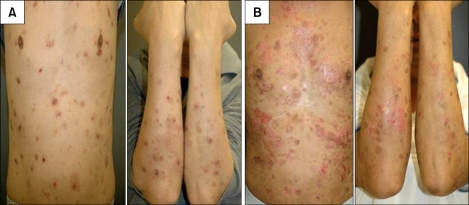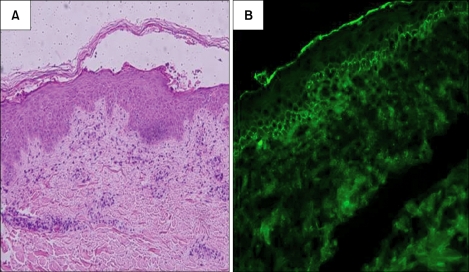Abstract
Although psoriasis and bullous diseases are considered to be completely different disease entities, the literature has reported a few cases of psoriasis associated with bullous diseases, most of which are bullous pemphigoid. In limited cases, pemphigus foliaceus has also been reported in association with psoriasis. In most of them, pemphigus lesions usually developed on an untreated patient with a chronic history of psoriasis. Herein, we report a case of 53-year-old male with a chronic history of psoriasis who first developed generalized erosive lesions after 26 cycles of narrow-band ultraviolet B (NBUVB) therapy. A diagnosis of pemphigus foliaceus was made based on skin biopsy and direct immunofluorescence assay. Pemphigus lesions were well controlled with combination therapy of oral steroid and azathioprine. This is the first case where pemphigus foliaceus co-occurred with psoriasis during NBUVB therapy.
Keywords: Narrow-band UVB, Pemphigus foliaceus, Psoriasis
INTRODUCTION
Since the first report of Bloom1 in 1929, the literature has reported a few cases of psoriasis coexistent with autoimmune bullous diseases. Bullous pemphigoid is the most frequent association observed, while pemphigus foliaceus has been reported to be coexistent with psoriasis in a few cases2-8. Whether the triggering stimuli imposed during psoriasis treatments or psoriasis itself is ultimately responsible for the induction of pemphigus has not been clearly elucidated. This is interesting, because possible pathogenic relations between pemphigus and psoriasis could be explained by a local microenvironment that favors a second autoimmune response. Herein, we report the first case of a patient with a chronic history of psoriasis who developed pemphigus foliaceus during narrow-band ultraviolet B (NBUVB) treatment.
CASE REPORT
A 53-year-old male, who had suffered from psoriasis since the age of 40, was referred to our psoriasis clinic because topical steroids had not been at all effective. He had been treated with broad-band UVB phototherapy eight years prior for one month, and it was effective with no side effects. On physical exam, there were erythematous squamous psoriatic plaques on the trunk, groin, and extensor side of the extremities (Fig. 1A). The initial Psoriasis Area and Severity Index score was 24.8. Laboratory investigations were within normal limits except for hypercholesterolemia (289 mg/dl) and erythrocyte sedimentation rate elevation (28 mm/h). NBUVB phototherapy was started from 500 mJ/cm2, with a 20% dosage increment, and he received the cumulative dose of 65,960 mJ/cm2 for two months. After the 26th treatment of phototherapy (UV dose: 3,960 mJ/cm2), several erosive lesions were observed around the trunk and extensor surface of the arms (Fig. 1B). Nikolsky sign was positive. Phototherapy was discontinued, and skin biopsy performed from the erosive lesions showed acantholysis of the upper epidermis with moderate perivascular infiltration of lymphocytes and eosinophils (Fig. 2). The direct immunofluorescence demonstrated intercellular deposition of IgG. Another biopsy specimen from the erythematous squamous plaques revealed psoriasis vulgaris. Once diagnosed with the coexistence of pemphigus foliaceus and psoriasis vulgaris, the patient was treated with oral prednisolone (45 mg daily) and azathioprine (100 mg daily). In the following four weeks after medication, almost complete remission of the erosive lesions was observed, and the patient has been maintained on a low dose of oral steroid and azathioprine.
Fig. 1.
(A) Typical nummular type psoriasis at patient's initial visit. (B) Development of flaccid vesicles and erosive lesions after receiving 26 cycles of narrow-band ultraviolet B therapy (Total irradiation dose: 65, 930 mJ).
Fig. 2.
(A) Acantholysis of the upper epidermis, moderate dermal infiltration of lymphocytes from erosive lesions (H&E, ×200). (B) Direct immunofluorescence on perilesional tissue showing intercellular IgG deposition.
DISCUSSION
Pemphigus foliaceus is an autoimmune blistering disorder characterized by granular layer acantholysis as a result of autoantibodies to a cell adhesion molecule, desmoglein 1. Compared with bullous pemphigoid and pemphigus vulgaris, only seven cases of pemphigus foliaceus coexistent with psoriasis vulgaris have been reported in the English literature2-8 (Table 1). Although the clinical features of each case were somewhat different, we could find some notable points. First, pemphigus foliaceus developed on pre-existing psoriasis in six cases with the exception of a single case2, where two diseases were found simultaneously. The period between appearance of psoriasis and pemphigus foliaceus varied from 8 months to 52 years, depending on cases. In our case, pemphigus was observed after 13 years had passed since the initiation of psoriasis. Second, pemphigus foliaceus developed on untreated psoriasis in 6 out of a total of 7 patients. One patient3 developed pemphigus foliaceus during PUVA therapy, although the total amount of irradiation was not recorded in detail. In our case, the patient developed pemphigus foliaceus during NBUVB therapy, which has never been reported. Third, the histological patterns were dependent on the lesions chosen for biopsy in 6 out of 7 patients. The psoriasis and pemphigus lesions of each patient demonstrated their characteristic histologies. Only one case4 demonstrated an intermingled pattern. Last, the clinical course of pemphigus foliaceus was benign in all cases. Bullous lesions were soon improved after taking oral prednisolone or other immunosuppressive drugs in every report, including our case.
Table 1.
Information on patients with pemphigus foliaceus coexisting with psoriasis in English literature
F: female, M: male, PF: pemphigus foliaceus, NA: not available, MTX: methotrexate, IM: intramuscular injection. *Mixed: histologic pattern of skin lesion showed intermingled traits of both psoriasis and PF, Separate: histologic pattern of skin lesion was dependent on the type of lesion chosen for biopsy.
Some cases of bullous pemphigoid and pemphigus vulgaris coexistent with psoriasis have been reported to be associated with PUVA or NBUVB treatment9-12. While a previous report13 demonstrated that NBUVB exposure of uninvolved skin of patients with fogo selvagem exacerbated acantholysis of the epidermis triggered by autoantibodies, this is the first case of UVB irradiation that might be directly associated with induction of pemphigus foliaceus in a patient suffering from psoriasis without previous history of bullous diseases. The pathogenesis might be partly understood in the context of "epitope spreading of autoimmune disease," proposed by Chan et al.14. It is probable that inflammatory processes triggered by NBUVB irradiation might have provided a microenvironment for the epidermal exposure of desmoglein antigens and facilitated interactions with a cutaneous immune system. Excessive atypical lymphocytes of underlying psoriasis would raise the possibility of this secondary autoimmune reaction. We might also consider the role of genetics for susceptible patients, since HLA DRB1 alleles have been reported to be associated with both psoriasis15 and pemphigus foliaceus16. Further genetic studies might help to elucidate the exact mechanism of this clinical observation.
We herein report a case of pemphigus foliaceus that was first observed during NBUVB therapy of psoriasis. We think that the diagnosis of pemphigus foliaceus should also be kept in mind for the skin erosions of psoriatic patients receiving NBUVB phototherapy.
References
- 1.Bloom D. Psoriasis with superimposed bullous eruption. Med J Rec. 1929;130:246. [Google Scholar]
- 2.Lee CW, Ro YS, Kim JH, Kim JH. Concurrent development of pemphigus foliaceus and psoriasis. Int J Dermatol. 1985;24:316–317. doi: 10.1111/j.1365-4362.1985.tb05792.x. [DOI] [PubMed] [Google Scholar]
- 3.Aghassi D, Dover JS. Pemphigus foliaceus induced by psoralen-UV-A. Arch Dermatol. 1998;134:1300–1301. doi: 10.1001/archderm.134.10.1300-a. [DOI] [PubMed] [Google Scholar]
- 4.Tomasini D, Cerri A, Cozzani E, Berti E. Development of pemphigus foliaceus in a patient with psoriasis: a simple coincidence? Eur J Dermatol. 1998;8:56–59. [PubMed] [Google Scholar]
- 5.Perez GL, Agger WA, Abellera RM, Dahlberg P. Pemphigus foliaceus coexisting with IgA nephropathy in a patient with psoriasis vulgaris. Int J Dermatol. 1995;34:794–796. doi: 10.1111/j.1365-4362.1995.tb04400.x. [DOI] [PubMed] [Google Scholar]
- 6.Yokoo M, Oka D, Ueki H. Coexistence of psoriasis vulgaris and pemphigus foliaceus. Dermatologica. 1989;179:222–223. doi: 10.1159/000248369. [DOI] [PubMed] [Google Scholar]
- 7.Giomi B, Cardinali C, Pestelli E, Caproni M, Fabbri P. Pemphigus foliaceus developing on pre-existing psoriasis: a supposed pathogenetic linkage. Acta Derm Venereol. 2004;84:82–83. doi: 10.1080/00015550310020567. [DOI] [PubMed] [Google Scholar]
- 8.Lee CW, Ro YS. Pemphigus developed on preexisting dermatoses. J Dermatol. 1994;21:213–215. doi: 10.1111/j.1346-8138.1994.tb01724.x. [DOI] [PubMed] [Google Scholar]
- 9.Fryer EJ, Lebwohl M. Pemphigus vulgaris after initiation of psoralen and UVA therapy for psoriasis. J Am Acad Dermatol. 1994;30:651–653. doi: 10.1016/s0190-9622(09)80116-3. [DOI] [PubMed] [Google Scholar]
- 10.Sanchez-Palacios C, Chan LS. Development of pemphigus herpetiformis in a patient with psoriasis receiving UV-light treatment. J Cutan Pathol. 2004;31:346–349. doi: 10.1111/j.0303-6987.2004.0188.x. [DOI] [PubMed] [Google Scholar]
- 11.Kirtschig G, Chow ET, Venning VA, Wojnarowska FT. Acquired subepidermal bullous diseases associated with psoriasis: a clinical, immunopathological and immunogenetic study. Br J Dermatol. 1996;135:738–745. [PubMed] [Google Scholar]
- 12.Abel EA, Bennett A. Bullous pemphigoid. Occurrence in psoriasis treated with psoralens plus long-wave ultraviolet radiation. Arch Dermatol. 1979;115:988–989. doi: 10.1001/archderm.115.8.988. [DOI] [PubMed] [Google Scholar]
- 13.Reis VM, Toledo RP, Lopez A, Diaz LA, Martins JE. UVB-induced acantholysis in endemic Pemphigus foliaceus (Fogo selvagem) and Pemphigus vulgaris. J Am Acad Dermatol. 2000;42:571–576. [PubMed] [Google Scholar]
- 14.Chan LS, Vanderlugt CJ, Hashimoto T, Nishikawa T, Zone JJ, Black MM, et al. Epitope spreading: lessons from autoimmune skin diseases. J Invest Dermatol. 1998;110:103–109. doi: 10.1046/j.1523-1747.1998.00107.x. [DOI] [PubMed] [Google Scholar]
- 15.Cardoso CB, Uthida-Tanaka AM, Magalhães RF, Magna LA, Kraemer MH. Association between psoriasis vulgaris and MHC-DRB, -DQB genes as a contribution to disease diagnosis. Eur J Dermatol. 2005;15:159–163. [PubMed] [Google Scholar]
- 16.Pavoni DP, Roxo VM, Marquart Filho A, Petzl-Erler ML. Dissecting the associations of endemic pemphigus foliaceus (Fogo Selvagem) with HLA-DRB1 alleles and genotypes. Genes Immun. 2003;4:110–116. doi: 10.1038/sj.gene.6363939. [DOI] [PubMed] [Google Scholar]





